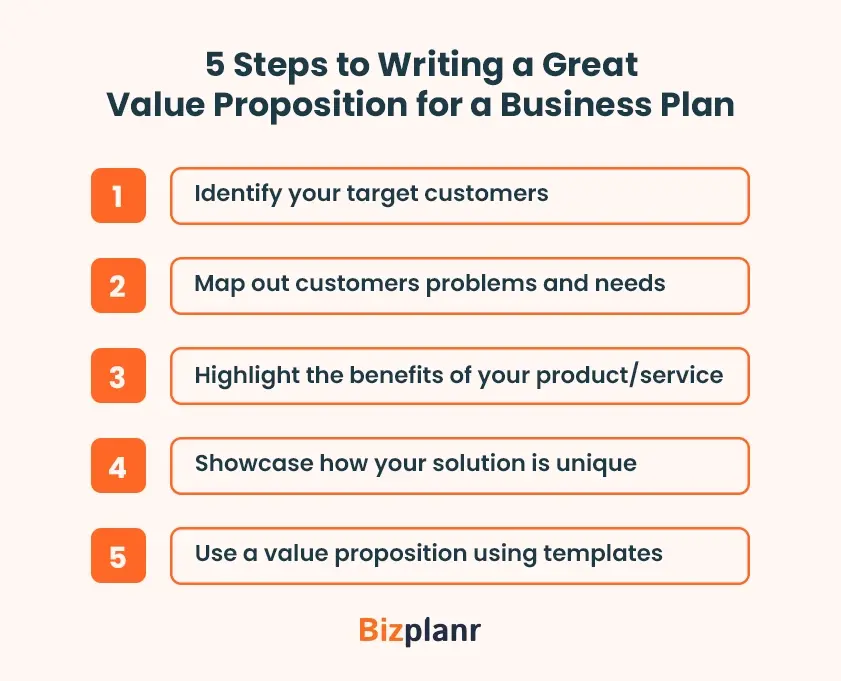A value proposition is a clear and compelling description of how your business will meet customers' demands in a way that your competitors don't.
Hence, it’s a crucial part of your business plan, as other marketing strategies and pitches rely on it.
Yet, many entrepreneurs fail to develop compelling value propositions or settle for vague ones.
A not-so-great value proposition in a business plan can hinder your business objectives and reduce the effectiveness of attracting investors.
That's where this blog comes to the rescue. Here, you’ll explore a value proposition, how to write it effectively in your business plan, and examples of the real world that made a difference.
Let's dive in.
What is a value proposition?
To put it simply, “it’s a promise of value that a business delivers to customers in exchange for their business.”
A value proposition clearly explains how your product or service solves a customer problem and highlights specific benefits that set you apart from competitors.
For example, if you’re running a coffee shop, your value proposition might be, “We offer freshly brewed, organic coffee at affordable prices with a cozy environment, ensuring a great start to your day.”
Together, these elements solve the customer’s problem of needing quality coffee, affordability, and a pleasant experience all in one place.
The main aim of the value proposition is to provide solutions that customers are looking to solve their pains. It’s all about selling a specific solution rather than a product or service.
With a clear understanding of what a value proposition is, let’s dive into…
5 Steps to writing a great value proposition for a business plan
To supercharge your sales and impress your stakeholders, follow these 5 steps to write a good value proposition for a business plan:
Step 1: Identify your target customers
To write a value proposition in a business plan, start with whom you're going to serve. That means who your audience will be, what product you will serve them, and why.
Precisely make a note of your customer with their location, behavior, needs, and demographics that help you market your company effectively.
You can create a customer persona, as mentioned below, to identify your customer. It will help you visualize the customer you're targeting and make informed decisions:
| Value proposition | Persona 1 | Persona 2 | Persona 3 |
|---|---|---|---|
| Customer's pain point | |||
| What is important for them? | |||
| Where are they located? | |||
| What is their demographic profile? | |||
| Key message |
Further, making a note of your customer for identification will help your company create a client persona you want to target. This client profile or persona will also help you identify who isn’t your ideal customer.
Remember, your business can't be all things to all customers, and if you do so, your value proposition will become diluted and confusing.
For example, if you're launching a fitness app and trying to cater to everyone—athletes, casual users, and seniors—your value proposition will become unclear.
Instead, focus on a specific audience, like busy professionals, and offer something like: "Quick, 20-minute workouts for busy professionals, anytime, anywhere." This clarity helps you stand out.
Once you become clear about the customer you don't want, then you can shift your focus to being clear about your value proposition and reach your business goal effectively.
Step 2: Map out customers problems and needs
Customers have their own pain points and needs and are looking for the right solution. While crafting your value proposition in a business plan, map out how your offerings will relieve customers’ pains or address their needs.
For example, you're offering a sleep solution product. Instead of just saying "we sell pillows," map out the emotional problem: "Many people struggle with restless nights and fatigue, affecting their mood and productivity."
Then, position your solution: "Our pillows are designed to provide optimal support, ensuring a restful night's sleep so you wake up refreshed and ready to take on the day."
See how the value proposition isn't just about money, time, and convenience but also the emotional benefits that customers will get from your product and services?
So, consider your customers' problems from an emotional perspective, as well as other angels to give you an edge.
Step 3: Highlight the benefits of your product/service
It's important to showcase how your product/services will benefit your customer from other competitors.
Emphasizing the benefits your business offers in a business plan creates a competitive advantage and leaves a positive impression on investors about your product.
Cindy Chambers, BDC Business Advisor advises “You want to be quite specific, using numbers or percentages. ‘Our product will reduce your energy costs by up to 25%’—that’s the kind of messaging you want to capture in your value proposition.”
In the modern world simply saying "we can help you" isn't enough. You need to be specific, using numbers and percentages to make your point clear and specific.
Focusing on tangible benefits your product or service will provide your customers, such as cost savings, time efficiency, improved performance, or an enhanced user experience, will enhance your business plan efficiency.
Step 4: Showcase how your solution is unique
This is essential to impress investors and stakeholders.
When they review your business plan and discover your company’s unique selling point in the value proposition section, it becomes a pivotal factor in gaining their trust and support. It shows them that you have a distinct edge in the market and risk of failure is low.
Moreover, just mentioning “I am better, I am different, and I am unique” isn’t enough. You need to demonstrate the pain points and show how your product/service can help with the solution.
One way to do so is by coming up with case studies, user testimonials, and real-world examples that show how your product or service directly addresses specific customer pain points.
For instance, share a case where a client’s business faced a challenge, and your product provided a clear, measurable solution. Highlight statistics, growth in percentage, and graphs to gain confidence.
Step 5: Use a value proposition using templates
To create a compelling value proposition in your business plan, structured templates are the way to go.
They offer a clear framework that guides you in articulating your unique value concisely.
Each template typically includes key elements such as your target customer, their pain points, your solution, and the benefits your product or service provides.
By utilizing value proposition templates, you can streamline the writing process and ensure you address all critical aspects of your value proposition effectively.
That said…
Why is value proposition crucial in a business plan?
The purpose of a value proposition is to communicate why a consumer should choose your product or service over another, emphasizing both tangible and intangible benefits.
Here are more aspects that make value proposition crucial in a business plan are as follows:
1) Articulates the clear purpose of business
According to a report by Forbes, 35% of startups fail because there’s no market need for their product or service.
However, if they had focused on their value proposition, the chances of failure would have significantly reduced. That’s because the value proposition is one of the factors that influence business success.
This is because it clearly articulates the benefits your business offers. It helps measure how your product stands out, who it will serve, and how much demand exists for it.
If you don't include a value proposition in your business plan, you can’t assess factors, increasing the likelihood that, like many other startups, you may end up closing your business.
Benchmark founder Andy Rachleff believes, "When starting a company, you need to develop a value hypothesis and then a growth hypothesis. The value hypothesis consists of the what, the who, and the how. What are you going to build? For whom is it relevant? And what's the business model? That's the how."
2) Differentiates your business from competitors
A strong value proposition clearly communicates what differentiates your product or service from your competitors.
By highlighting the unique benefits you offer, and showcasing how your solution solves problems more effectively than others, it helps position your business as the preferred choice in the market.
Such unique benefits attract your target customers and build trust as well as loyalty, giving you a competitive edge.
Today's customers are more selective and seek new, unique choices. A strong and unique value proposition helps your business stand out by clearly showing what differentiates your product or service from competitors.
3) Enhances customer engagement
Value propositions enhance customer engagement by clearly communicating your business's benefits and addressing customer needs.
In your business plan, they serve as a guiding tool for customer interaction, ensuring that your messaging is focused on solving their key problems.
As Tom Morrison, the CEO of Metal Treating Institute, said, value propositions are about solving the biggest challenges customers face. When you solve these pain points, customers will stay loyal, making it easier to build long-term engagement and trust in your brand.
Including a value proposition in your business plan is a guiding tool, making customers quickly understand what sets you apart and how you can improve their lives.
Such connection and understanding make them feel more attached and are more likely to stay engaged.
4) Provides competitive advantage
A strong value proposition gives your business a competitive edge by highlighting what sets you apart from others in the market.
It clearly explains why your product or service is the better choice for your potential clients.
By focusing on unique benefits that your competitors can't match, your value proposition positions your business as the preferred option, helping you attract and retain customers more effectively.
5) Attracts investors
For startups and growing businesses, a compelling value proposition is often the first thing investors look for. It helps convey the business's potential and market positioning, making it easier to secure funding.
Furthermore, a strong value proposition reflects:
- Scalability
- Reduce the risk to investors
- Highlights a well-thought-out path to profitability
- Deliver value that will drive sales and customer loyalty
- Reassures investors that your business has a solid foundation
- Assure confidence in the potential return on their investment
Now, after going over all these points you might be wondering how it compares to a mission statement. Don’t worry, we’ll clarify the confusion to better explain the value proposition.
Value proposition vs. Mission statement
If the value proposition already answers the questions of why, whom, and how, then what’s the purpose of a mission statement?
In this section, let’s take a look at the differences between a value proposition and a mission statement so you can easily understand the importance of both.
| Aspect | Value Proposition | Mission Statement |
|---|---|---|
| Purpose | Describes the unique value your product or service provides, focusing on why customers should choose you. | Defines the company's overall purpose and the impact it aims to have in the long run. |
| Focus | Customer-focused: Solves a specific problem and highlights the benefits to customers. | Company-focused: Reflects the company's core values, culture, and goals. |
| Time Frame | Short-term, adaptable as customer needs and market conditions evolve. | Long-term, serves as a guiding principle that rarely changes. |
| Communication | Clear and direct: Designed to quickly convey the value to customers, often in a few seconds. | Broad and inspirational: Communicates the company’s vision and mission to employees, customers, and stakeholders. |
| Audience | Primarily targets potential customers and clients. | Aimed at both internal stakeholders (employees) and external audiences (customers, investors). |
| Length | Typically brief, often one to two sentences. | Usually longer, providing a more comprehensive overview of the organization's goals. |
| Examples | "Our marketing automation platform helps you convert leads into customers." | "We are on a mission to empower businesses to grow through data-driven marketing." |
The table explains that a value proposition is focused on immediate customer value and market differentiation, while a mission statement is about the long-term goals and values of the company.
In terms of communication, value propositions grab attention quickly, while mission statements serve as inspiring guides for everyone involved in the business.
Real-world value proposition examples
Here are a few unique value proposition examples that will make you understand their importance in a business plan precisely:
Example 1
Company Name: Apple
Product Name: iPhone 16
“Built for Apple Intelligence”
The iPhone 16 offers a seamless blend of cutting-edge AI technology and smart functionality as suggested on the website’s home page.
With advanced AI integration, it provides a personalized user experience that adapts to your needs.
From its durable Ceramic Shield design to long-lasting battery life and a pro-level camera system, every feature is designed to simplify and enhance your daily life.
Value proposition: Apple's iPhone 16 demonstrates how AI can be used to create personalized user experiences.
Example 2
Company Name: Nike
Product Name: Running shoes
Nike inspires athletes to push their limits with innovative products designed for peak performance, encapsulating the spirit of perseverance and the belief that true victory comes from embracing discomfort.
Value proposition: Nike’s value proposition lies in its ability to inspire athletes at all levels, offering innovative, high-quality products that drive peak performance.
By tapping into the emotional connection with athletes, Nike embodies the spirit of perseverance and motivates individuals to push beyond their limits.
Conclusion
Value proposition in a business plan is a key aspect that defines the unique benefits your product or service offers to customers. It serves as a critical tool for distinguishing your business from competitors.
Therefore, implement the steps mentioned, refer to the value proposition examples, and consider the importance of a value proposition discussed in this blog before crafting your own.
However, the value proposition is only one component of a business plan. You need a comprehensive business plan to achieve business success and secure funding.
If you want to create an effective business plan encompassing all aspects of your business, including the value proposition, consider using our AI-powered business plan generator.
By answering a few simple questions, you can generate a compelling business plan that helps you gain the confidence of your stakeholders and sets your product/services apart from the competition.
Try out today!
Get Your Business Plan Ready In Minutes
Answer a few questions, and AI will generate a detailed business plan.
Frequently Asked Questions
Where should the value proposition go in a business plan?
Your value proposition should be prominently featured in the executive summary or marketing section of your business plan. It communicates how your product or service solves key problems for your target customers.
This section guides your overall marketing strategy and aligns your messaging with customer needs. Using a value proposition canvas can help clarify how your offering stands out from competitors.
How long should a value proposition be?
A value prop should be clear, concise, and to the point. Ideally, your value proposition statement should be no longer than a few sentences. The focus is on delivering key messages about your company’s product or service that resonate with your target customer quickly and effectively.
Can a business have more than one value proposition?
Yes, a business can have multiple value propositions, mainly if it serves different target customer segments or offers diverse products and services. However, each value proposition statement should be tailored to the specific needs of each customer group to ensure clarity and relevance.
How do I know if my value proposition is effective?
Your value prop is effective if it resonates with your target customer and leads to engagement, conversions, or customer loyalty. Tools like the value proposition canvas can help you assess how well your product or service aligns with your customer's needs. And whether you're clearly addressing their pain points as well as delivering the promised benefits.









